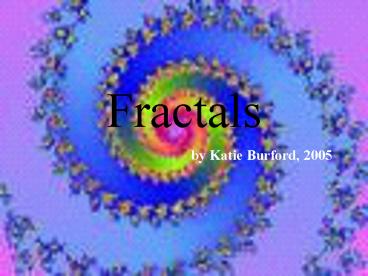Fractals - PowerPoint PPT Presentation
1 / 11
Title:
Fractals
Description:
... example, the geometry you study about ... Much of fractal geometry, however, is much newer. ... http://mathforum.org/alejandre/workshops/fractal/fractal3.html ... – PowerPoint PPT presentation
Number of Views:1083
Avg rating:3.0/5.0
Title: Fractals
1
Fractals
by Katie Burford, 2005
2
What are Fractals?
- They're everywhere, those bright, weird,
beautiful shapes called fractals. But what are
they, really? - Fractals are geometric figures, just like
rectangles, circles and squares, but fractals
have special properties that those figures do not
have. - There's lots of information on the Web about
fractals, but most of it is either just pretty
pictures or very high-level mathematics. Lets
see if we can make it simple!
Info from http//math.rice.edu/lanius/frac/
3
Why Study Fractals?
- They're New!
- Most math you study in school is old knowledge.
For example, the geometry you study about
circles, squares, and triangles was organized
around 300 B.C. by a man named Euclid. Much of
fractal geometry, however, is much newer.
Research on fractals is being carried out right
now by mathematicians. Have you ever thought
about a career as a mathematician? - You can understand them!
- Much research in mathematics is currently being
done all over the world. Most of it is extremely
complicated. Although we need to study and learn
more before we can understand most modern
mathematics, there's a lot about fractals that we
can understand.
Info from http//math.rice.edu/lanius/frac/
4
Properties of Fractals
- Self-Similarity
- Many figures that are not fractals are
self-similar. Notice the figures below. Notice - that the outline of the figure is a trapezoid.
Now look inside at all the trapezoids that - make up the larger trapezoid. This is an example
of self similarity. - To the left is the fractal named Sierpinski
Triangle. Notice that the outline of the
figure is an equilateral triangle. Now look
inside at all the equilateral triangles. How
many different sized triangles can you find?
All of these are similar to each other and to the
original triangle - All fractals are self-similar
Info from http//math.rice.edu/lanius/frac/
5
- Iterative Formation
- An iterative process is a repetitive operation.
In a fractal it begins with a simple geometric
shape then by iteration the figure gets more and
more complicated. - The iteration above will eventually create a
famous fractal called The Koch Snowflake - All Fractals are formed in this manner.
Info from http//math.rice.edu/lanius/frac/
6
7
8
Fractals are used to model nature!
9
- And to predict the change in the shore line
after a major storm like Hurricane Katrina.
10
Make your own Fractal!
- Step One -Draw an triangle. Connect the
midpoints of each side. How many triangles do
you now have? Shade out the triangle in the
center. Think of this as cutting a hole in the
triangle. - Step Two -Connect the midpoints of the sides of
the remaining triangles and shade the triangle in
the center as before. Notice the three small
triangles that also need to be shaded out in each
of the three triangles on each corner - three
more holes. - Step Three -Follow the same procedure as before,
making sure to follow the shading pattern. You
will have 1 large, 3 medium, and 9 small
triangles shaded. - Step Four -Follow the above pattern and complete
the Sierpinski Triangle - Step Five Now try it again with another shape
(not a triangle!)
11
Cool Fractal Links
- http//www.bugman123.com/Fractals/Fractals.html
- http//fotofects.com/v2/adobe-photoshop/fractals.h
tml - http//www.fractalexperience.com/
- http//www.fbmn.fh-darmstadt.de/home/sandau/biofra
ctals/abstract_sfi.html - http//archive.ncsa.uiuc.edu/Edu/Fractal/Fractal_H
ome.html - http//sprott.physics.wisc.edu/fractals.htm
- http//www.math.umass.edu/mconnors/fractal/fracta
l.html - http//mathforum.org/alejandre/workshops/fractal/f
ractal3.html - http//www.ealnet.com/ealsoft/fracted.htm
- http//www.geom.uiuc.edu/java/LeapFractal/































